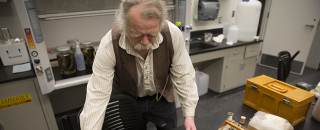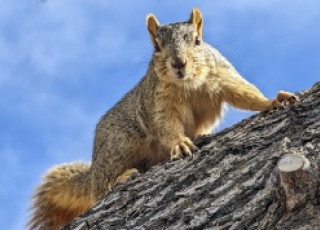NHMU Partners with the Public to Log Utah Squirrel Sightings
Salt Lake City – The Natural History Museum of Utah (NHMU) will host its weeklong Squirrel Fest Dec. 6–12, 2021. The festival will be hosted as a do-it-yourself, socially-distanced event for a second year in a row. And, while there won’t be a grand in-person celebration planned, the mission of Squirrel Fest is of grand importance to the museum: To rally Utahns as Citizen Scientists to help track the distribution of squirrels in the state.
Led by Eric Rickart, NHMU’s curator of vertebrates, and Ellen Eiriksson, the museum’s Citizen Science program manager, Squirrel Fest is doing what the American Audubon Society’s Christmas Bird Count has done for more than 100 years across the nation. By crowd sourcing public contributions of wildlife sightings, biologists can better track animal population distribution and trajectory. In this case, NHMU is tracking Utah’s squirrels and—in the digital age—doing so on a grander scale.
By using the iNaturalist app or by filling out a form on NHMU’s website, the public can record squirrel observations to help biologists like Rickart follow the spread of species and better understand their impacts on our environment. One example is the fox squirrel, which was introduced to Utah around 2010 and has spread rapidly—especially in the urban landscape of Salt Lake City.
“The fox squirrel provides an opportunity to study how a non-native species becomes established in a new environment. In the past five years, fox squirrels have rapidly expanded their range along the Wasatch Front and are adapting to the urban environment,” Rickart said.
In 2020 alone, Citizen Scientists in Utah contributed more than 400 observations of Utah’s squirrels, often with detailed notes on behavior. This combined data becomes a valuable part of Rickart’s research. In his 30 years of studying mammals, the seasoned biologist believes Citizen Science contributions—in efforts like Squirrel Fest—are collectively one of the most valuable tools at his disposal.
“Citizen science has been around for a very long time, but it has really taken off in recent years with the advent of new technologies that enable anyone to collect and share their own scientific observations,” Rickart said.
The number and quality of observations NHMU has received clearly emphasizes the public’s fascination with these charismatic critters that share our backyards and neighborhoods. Both Rickart and Eiriksson hope to continue recruiting Citizen Scientists through events like Squirrel Fest.
“We’re excited to see so many observations from our community, and we are so grateful to those who take a few minutes to report information about squirrels,” Eiriksson said. “This year, we hope to continue receiving observations from well-reported areas, like Salt Lake County, as well as areas where we haven’t yet recorded many squirrels, like Davis, Morgan, and Utah counties.”
The data collected by Citizen Scientists will support research by Rickart and others on Utah’s mammals and will be added to online databases that are available to scientists around the world. It will also benefit scientific research conducted many years from now, offering an extensive record of how animal populations change over time.
If you wish to learn more about Utah’s squirrels or Citizen Science, you can join both Rickartand Eiriksson at Squirrel Fest outreach events happening on Dec. 4 at Liberty Park and Dec. 11at the International Peace Gardens in Salt Lake City. More information about these events can be found on the museum’s website at https://nhmu.utah.edu/squirrels.

